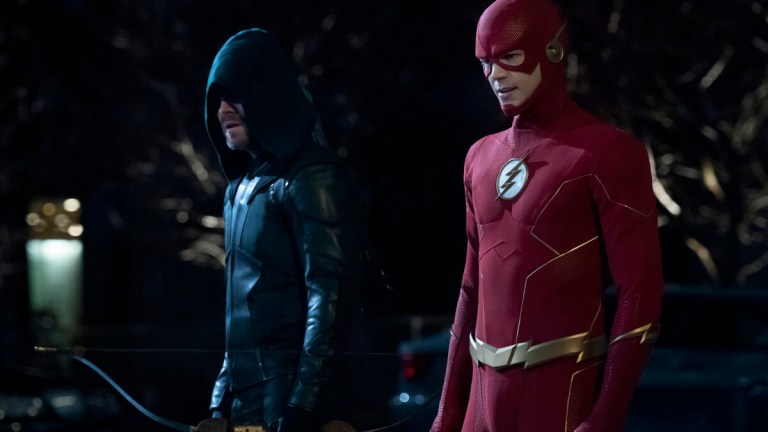The Flash: Stephen Amell’s Arrow Return and the Beginning of the End for the Series
Exclusive: Danielle Panabaker breaks down directing The Flash Season 9's biggest episode yet, from Stephen Amell's return to the Arrowverse to Khione's future and more.

This article contains The Flash spoilers.
The Flash Season 9 Episode 9
The end is truly nigh. After a handful of more standalone-style “interlude” episodes, The Flash enters its endgame with an hour that brings back old favorites and takes big narrative swings, restoring the multiverse and reminding Barry Allen of why he became a hero in the first place.
Any The Flash episode that features the long-awaited return of Keiynan Lonsdale as Wally West, as well as guest appearances from Arrow stars Stephen Amell and David Ramsey, is basically guaranteed to be a must-watch, but “It’s My Party And I’ll Die If I Want To” is a surprisingly emotional installment on top of that, one that offers several characters some much-needed closure and a chance to rededicate themselves to fighting the good fight.
“Honestly, I’m so thrilled that this was the episode I got to direct,” says Danielle Panabaker, who plays Khione and helmed the episode. “Especially because initially they just assign you a number—like, okay, you’re going to be directing episode nine—and it wasn’t until further into the season when they’d actually broken the stories that I knew what would be coming. But I’m so glad it was me. As someone who’s been part of the Arrowverse for a long time, and knows The Flash intimately, but also knows Arrow and the history with those characters, it was so important to me to do justice to all these different storylines.”
In many ways, entrusting an episode that touches on so many legacy relationships and themes to a person who’s seen most of them unfold both on and off-screen makes a ton of sense. “It’s My Party and I’ll Die If I Want To” is the fifth The Flash episode that Panabaker has directed, following Season 5’s “Godspeed,” Season 6’s “License to Elongate,” Season 7’s “Rayo de Luz,” and Season 8’s “Keep It Dark.” But she credits the ultimate success of this episode to a team effort between its writers and guest cast.
“It was a really stellar script—Sam [Chielsen] and Emily [Palizzi] did an excellent job, and Sam, in particular, is a big fan of Arrow and I feel like he knew Oliver’s voice and could really make sure we got that tone,” Panabaker says. “And although it’s a big episode, it’s actually not a crazy number of scenes, which is fun because every[one] gets to be really interesting and there’s a lot going on [in them]. So it’s not just two people sitting at a desk talking about something.”
According to the director/actress, conveying the story’s emotional beats was just as important to her as handling the many visual and special effects necessary to create Bloodwork’s zombies. Particularly since so much of its story hinges on relationships: Between Barry and his brother-in-law Wally, between Barry and his former mentor Oliver Queen, and even between Barry and his own mission as The Flash.
“It’s My Party and I’ll Die If I Want To” focuses on Barry’s second 30th birthday party, something that’s only possible thanks to the fact that he was slightly de-aged during last season’s “The Curious Case of Bartholomew Allen.” But it’s not as happy an occasion as you might expect—he’s still struggling with the fact that he was essentially randomly gifted extra years of life when his friends like Caitlin and Frost are dead and gone.
“I think it’s important to really tell the story on a variety of different levels,” she continues. “At the start, it feels to me like one of our more old-school episodes in that there’s a bad guy, and it’s a really scary bad guy and we really have to stop him and stop him right now. So there’s an urgency to that. And to get to see the Flash be the Flash in that way is great. But I also think there’s a really interesting Barry story there too.”
For Panabaker, Barry’s “complicated history and backstory with Wally West” was of particular interest to her, especially since Wally has spent his time away from Central City on something of a journey of self-actualization, trying to find his way to true enlightenment. And in many ways, he seems more secure in himself, and his identity as a hero, than Barry is at this particular moment.
“I think Keiyan gives a really beautiful performance in this episode—that scene where they are on the balcony and it’s clear that Wally is talking about something with more depth and Barry initially understands. And I think the way Keiynan plays that scene is just so without judgment, and it really…keeps it from feeling like an afterschool special. It feels like two adults having a conversation and it really gives Barry somewhere to go, emotionally. And telling those stories is always so satisfying. I had a great time directing this episode and I’m really proud of it.”
Returning Arrowverse favorites Amell and Ramsey have smaller roles to play—though both Oliver and Diggle each get key scenes with Barry and one another over the course of the hour (and, of course, it’s Oliver, in his role as the Spectre, who reveals that the multiverse has been reborn). For Panabaker, the actors also brought some fresh energy to the set, as well.
“Kudos to Stephen, for really bringing it—and I think it was nice for our series regulars too. I think sometimes what we do can become a little bit mundane. But to have Stephen and David come back, who’d done the exact same thing for almost as many years and have that excitement, it was really contagious, and I think it made a difference. The cast really stepped up, and I think they really brought it.”
Due to her directing duties, Panabaker herself is largely absent from this episode. But her character, Khione, does play a pivotal role in defeating Sendhil Ramamurthy’s Bloodwork, using her newly discovered ice powers to freeze his mind-controlled zombies and her connection to the natural world to force the unnatural elements infecting Diggle out of his body. Yet, despite her increasingly powerful abilities, The Flash has been strangely reluctant to identify exactly what Khione is or fully explain her connection to Caitlin and Frost. But, according to Panabaker, that’s about to change.
“We’re going to start steamrolling to the end of the season, particularly with Khione and starting to see a little more about what’s going on with her,” Panabaker says. “We saw a taste of it when she made it snow in the lounge—she’s going to start to really lean into who she actually is, which is something we won’t fully discover until the season finale, but it’s pretty incredible.”
Although Khione is technically the third version of her original character that Panabaker has been charged with playing—fourth if you count the Earth-2 version of Killer Frost—the actress has found playing the third Snow sister (for lack of a better phrase) a more “light-hearted” role.
“There’s a lightness to her that I really like and I really try to lean into,” she says. “Because that’s something that, in our earlier seasons there was a little bit more of that levity and that innocence and that hopefulness. And a character like Barry can’t really embody that anymore because he has saved the day over a hundred times at this point. I think it’s nice to have Khione around to sort of fill that void.”
But, while Khione is certainly charming, many fans are still wondering what her existence truly means for Caitlin, a character who’s been part of The Flash since the series’ pilot. But the show’s shortened final season—just 13 episodes compared to the 22 or 23 of earlier seasons—has meant that it has had to serve a lot of masters, balancing more cast members and plotlines than ever before, even as it attempts to craft a satisfactory resolution to the series as a whole.
“I think when Eric [Wallace, showrunner of The Flash] originally conceived of having me play a new character in season nine, he had hoped there was going to be a season 10 as well,” Panabaker explains. “So I think conceptually, he was envisioning something different in terms of how long he’d have to tell certain stories, and I think you feel that in the beginning of season nine. Now we’re starting to hit our stride and really feel like it’s the end of the series. But we only had so much time and I understand that some stuff doesn’t always make it.”
Given how many characters and stories The Flash season 9 is already attempting to balance, maybe a satisfying resolution to Caitlin’s story in addition to Khione’s was always going to be a long shot (though it probably should be noted that The Flash showrunner insists that Caitlin will get a proper ending through this storyline, even if what that will ultimately look like remains unclear).
“I will say I was pretty vocal about wanting to see Caitlin one more time,” she says. “I am a Caitlin fan and I really wanted to see Caitlin too. I will say that was something that was important to me.”
With just four episodes left, it’s hard to know quite what to expect from The Flash’s final “graphic novel” (Wallace’s preferred term for the format in which he likes to divide a season). But although Panabaker certainly doesn’t come out and say so, it certainly sounds as though fans hoping for a chance to say a proper goodbye to Caitlin Snow might want to start preparing themselves for at least some level of disappointment.
“Here’s what I will say. When you are wrapping up a series, and particularly when you have to do a series finale, that’s really challenging because everyone has a different vision for what they want to see for this show and for their characters,” she explains. “And it’s hard, especially as an actor, because we don’t write these scripts. These are decisions that are made and not even just by one or two people, they’re made by committee. What do the writers want to see? What does the studio want to see? What does the network want to see? And so there’s a lot of cooks in the kitchen.”
But that doesn’t necessarily mean that viewers won’t have reason to believe in miracles, even if they may not get the chance to watch them play out.
“This is also another circumstance: I had seen a few revisions and I think I know more about the intention that was ultimately filmed, which is frustrating for the fans,” Panabaker admits. “But I will say that on the page, the series ends on a hopeful note and leaves a lot of doors open. So hopefully we can all imagine that Central City continues in a world and in a way that is satisfying to us. Does that make sense? Even if it’s not on the screen, that doesn’t mean it isn’t true. There’s always room for hope.”
